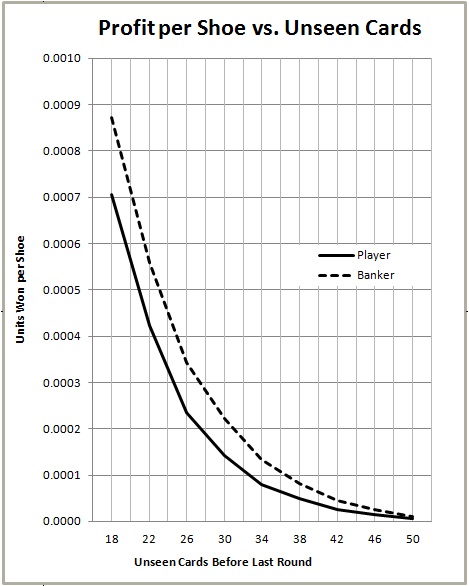The World's Greatest Baccarat Player

Without bothering about questions of legality, the world’s greatest baccarat player uses a computer. He dutifully enters cards into the program as they are dealt from the shoe. At the start of each round, the computer determines the exact edge for the Player and Banker bets based on the exact composition of the cards that remain in the shoe. The world’s greatest baccarat player then makes a Banker or Player bet when he has the edge over the house on that wager and at no other time. No card counting system can do better than computer-perfect play. And as we will see, computer-perfect baccarat play is a bust for the advantage player
If an edge is going to occur, the situation will most likely occur late in the shoe. The strength of the opportunities will be proportional to the number of unseen cards. I investigated situations where the number of unseen cards varied from 18 to 50 at the time of the wager. Beyond 50 cards, there were effectively no instances of a player edge over the house on either the Player or Banker bets. Likewise, most casinos use dealing procedures that rarely afford players an opportunity to make a wager with fewer than 18 unseen cards overall (including initial burn cards).
Here is a summary of how I proceeded:
- Fix a number of unseen cards. I ran simulations for 18, 26, 34, 42 and 50 unseen cards.
- Shuffle the eight-deck shoe.
- Deal out the shoe until the appropriate number of unseen cards is left.
- Determine the exact edge for both the Player and Banker based on the remaining unseen cards.
- Record the results.
- Go to step 2.
After repeating steps 2 through 6 for one hundred thousand (100,000) baccarat shoes, I imported the information into Excel where I determined the distribution of the house edge for both the Player and Banker bets. For each number of unseen cards, I then computed the bet frequency (the percent of hands where the player has the edge) and the average edge (assuming the player only makes a wager when he has the edge). I then computed the win per shoe for each of the Banker and Player bets, for each number of unseen cards, assuming the player made a $100 wager whenever he had the edge and otherwise made no wager.
For example, with 18 unseen cards, I obtained the following results for the Banker bet:
Computer-Perfect Play, Banker Bet, 18 Unseen Cards
- Bet frequency: 4.589%
- Average edge: 0.679%
- Win per shoe: $0.031
With 18 unseen cards, the player has the edge over the house making Banker bets on 4.589% of the hands. If the player only makes Banker bets when he has the edge, his average edge will be 0.679%. The player will earn $0.031 per shoe by making a $100 wager on the Banker bet whenever he has the edge.
With 18 unseen cards, I obtained the following results for the Player bet:
Computer-Perfect Play, Player Bet, 18 Unseen Cards
- Bet frequency: 5.909%
- Average edge: 0.479%
- Units won per shoe: $0.028
With 18 unseen cards, the player has the edge over the house making Player bets on 5.909% of the hands. If the player only makes Player bets when he has the edge, his average edge will be 0.479%. The player will earn $0.028 per shoe by making a $100 wager on the Player bet whenever he has the edge.
The following tables summarize the bet frequency, average edge and win per shoe with $100 bets:


After each round is dealt from the shoe, the player will have an opportunity to make his next baccarat wager with 4-to-6 fewer unseen cards than the previous round. Using the data above, I was able to plot the total possible units that could be won per shoe using computer perfect play, based on the number of unseen cards at the start of the final round of the shoe. The following chart gives this information:

To put this in dollars and cents, suppose the world’s greatest baccarat player sits down to play using computer-perfect strategy. Whenever he has the edge on the Banker bet, he wagers $1000 on it. Whenever he has the edge on the Player bet, he wagers $1000 on it. If his last wager occurs with 18 unseen cards, then:
- The profit per shoe for the Player bet is at most 70.5 cents per shoe.
- The profit per shoe for the Banker bet is at most 87.1 cents per shoe.
- The profit per shoe for making both Player and Banker bets is at most $1.58 per shoe.
Maybe he’s the world’s most perfect card counter. Or perhaps he is using a computer. Or maybe he is just psychic. It doesn’t matter. Just assume this player somehow knows exactly when he has the edge over the house and whenever he does, he bets $1000. The practical limitations on the earning potential for this player are profound — $1.58 per shoe for a wager size of $1000.
In other words, baccarat cannot realistically be beaten by card counting or computer-perfect play. Occam’s razor then dictates that a suspected advantage player is either lucky, using a stronger method or is a crook.


